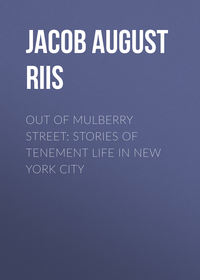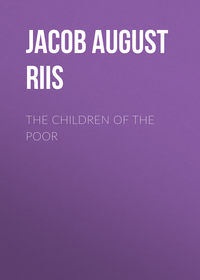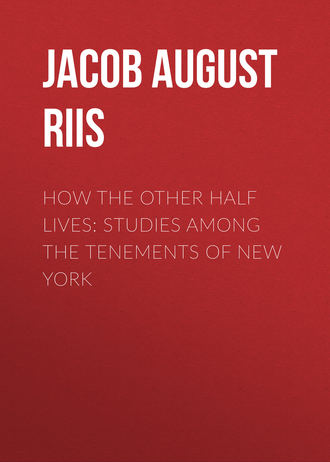 полная версия
полная версияHow the Other Half Lives: Studies Among the Tenements of New York

Jacob A. Riis
How the Other Half Lives: Studies Among the Tenements of New York
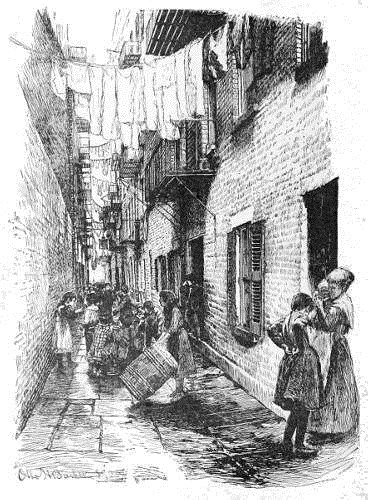
GOTHAM COURT.
PREFACE
The belief that every man’s experience ought to be worth something to the community from which he drew it, no matter what that experience may be, so long as it was gleaned along the line of some decent, honest work, made me begin this book. With the result before him, the reader can judge for himself now whether or not I was right. Right or wrong, the many and exacting duties of a newspaper man’s life would hardly have allowed me to bring it to an end but for frequent friendly lifts given me by willing hands. To the President of the Board of Health, Mr. Charles G. Wilson, and to Chief Inspector Byrnes of the Police Force I am indebted for much kindness. The patient friendship of Dr. Roger S. Tracy, the Registrar of Vital Statistics, has done for me what I never could have done for myself; for I know nothing of tables, statistics and percentages, while there is nothing about them that he does not know. Most of all, I owe in this, as in all things else, to the womanly sympathy and the loving companionship of my dear wife, ever my chief helper, my wisest counsellor, and my gentlest critic.
J. A. R.INTRODUCTION
Long ago it was said that “one half of the world does not know how the other half lives.” That was true then. It did not know because it did not care. The half that was on top cared little for the struggles, and less for the fate of those who were underneath, so long as it was able to hold them there and keep its own seat. There came a time when the discomfort and crowding below were so great, and the consequent upheavals so violent, that it was no longer an easy thing to do, and then the upper half fell to inquiring what was the matter. Information on the subject has been accumulating rapidly since, and the whole world has had its hands full answering for its old ignorance.
In New York, the youngest of the world’s great cities, that time came later than elsewhere, because the crowding had not been so great. There were those who believed that it would never come; but their hopes were vain. Greed and reckless selfishness wrought like results here as in the cities of older lands. “When the great riot occurred in 1863,” so reads the testimony of the Secretary of the Prison Association of New York before a legislative committee appointed to investigate causes of the increase of crime in the State twenty-five years ago, “every hiding-place and nursery of crime discovered itself by immediate and active participation in the operations of the mob. Those very places and domiciles, and all that are like them, are to-day nurseries of crime, and of the vices and disorderly courses which lead to crime. By far the largest part—eighty per cent. at least—of crimes against property and against the person are perpetrated by individuals who have either lost connection with home life, or never had any, or whose homes had ceased to be sufficiently separate, decent, and desirable to afford what are regarded as ordinary wholesome influences of home and family.... The younger criminals seem to come almost exclusively from the worst tenement house districts, that is, when traced back to the very places where they had their homes in the city here.” Of one thing New York made sure at that early stage of the inquiry: the boundary line of the Other Half lies through the tenements.
It is ten years and over, now, since that line divided New York’s population evenly. To-day three-fourths of its people live in the tenements, and the nineteenth century drift of the population to the cities is sending ever-increasing multitudes to crowd them. The fifteen thousand tenant houses that were the despair of the sanitarian in the past generation have swelled into thirty-seven thousand, and more than twelve hundred thousand persons call them home. The one way out he saw—rapid transit to the suburbs—has brought no relief. We know now that there is no way out; that the ‘system’ that was the evil offspring of public neglect and private greed has come to stay, a storm-centre forever of our civilization. Nothing is left but to make the best of a bad bargain.
What the tenements are and how they grow to what they are, we shall see hereafter. The story is dark enough, drawn from the plain public records, to send a chill to any heart. If it shall appear that the sufferings and the sins of the “other half,” and the evil they breed, are but as a just punishment upon the community that gave it no other choice, it will be because that is the truth. The boundary line lies there because, while the forces for good on one side vastly outweigh the bad—it were not well otherwise—in the tenements all the influences make for evil; because they are the hot-beds of the epidemics that carry death to rich and poor alike; the nurseries of pauperism and crime that fill our jails and police courts; that throw off a scum of forty thousand human wrecks to the island asylums and workhouses year by year; that turned out in the last eight years a round half million beggars to prey upon our charities; that maintain a standing army of ten thousand tramps with all that that implies; because, above all, they touch the family life with deadly moral contagion. This is their worst crime, inseparable from the system. That we have to own it the child of our own wrong does not excuse it, even though it gives it claim upon our utmost patience and tenderest charity.
What are you going to do about it? is the question of to-day. It was asked once of our city in taunting defiance by a band of political cutthroats, the legitimate outgrowth of life on the tenement-house level.1 Law and order found the answer then and prevailed. With our enormously swelling population held in this galling bondage, will that answer always be given? It will depend on how fully the situation that prompted the challenge is grasped. Forty per cent. of the distress among the poor, said a recent official report, is due to drunkenness. But the first legislative committee ever appointed to probe this sore went deeper down and uncovered its roots. The “conclusion forced itself upon it that certain conditions and associations of human life and habitation are the prolific parents of corresponding habits and morals,” and it recommended “the prevention of drunkenness by providing for every man a clean and comfortable home.” Years after, a sanitary inquiry brought to light the fact that“more than one-half of the tenements with two-thirds of their population were held by owners who made the keeping of them a business, generally a speculation. The owner was seeking a certain percentage on his outlay, and that percentage very rarely fell below fifteen per cent., and frequently exceeded thirty.2… The complaint was universal among the tenants that they were entirely uncared for, and that the only answer to their requests to have the place put in order by repairs and necessary improvements was that they must pay their rent or leave. The agent’s instructions were simple but emphatic: ‘Collect the rent in advance, or, failing, eject the occupants.’” Upon such a stock grew this upas-tree. Small wonder the fruit is bitter. The remedy that shall be an effective answer to the coming appeal for justice must proceed from the public conscience. Neither legislation nor charity can cover the ground. The greed of capital that wrought the evil must itself undo it, as far as it can now be undone. Homes must be built for the working masses by those who employ their labor; but tenements must cease to be “good property” in the old, heartless sense. “Philanthropy and five per cent.” is the penance exacted.
If this is true from a purely economic point of view, what then of the outlook from the Christian standpoint? Not long ago a great meeting was held in this city, of all denominations of religious faith, to discuss the question how to lay hold of these teeming masses in the tenements with Christian influences, to which they are now too often strangers. Might not the conference have found in the warning of one Brooklyn builder, who has invested his capital on this plan and made it pay more than a money interest, a hint worth heeding: “How shall the love of God be understood by those who have been nurtured in sight only of the greed of man?”
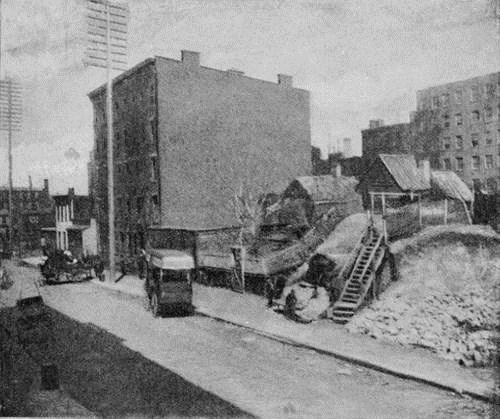
HELL’S KITCHEN AND SEBASTOPOL.
CHAPTER I.
GENESIS OF THE TENEMENT
The first tenement New York knew bore the mark of Cain from its birth, though a generation passed before the writing was deciphered. It was the “rear house,” infamous ever after in our city’s history. There had been tenant-houses before, but they were not built for the purpose. Nothing would probably have shocked their original owners more than the idea of their harboring a promiscuous crowd; for they were the decorous homes of the old Knickerbockers, the proud aristocracy of Manhattan in the early days.
It was the stir and bustle of trade, together with the tremendous immigration that followed upon the war of 1812 that dislodged them. In thirty-five years the city of less than a hundred thousand came to harbor half a million souls, for whom homes had to be found. Within the memory of men not yet in their prime, Washington had moved from his house on Cherry Hill as too far out of town to be easily reached. Now the old residents followed his example; but they moved in a different direction and for a different reason. Their comfortable dwellings in the once fashionable streets along the East River front fell into the hands of real-estate agents and boarding-house keepers; and here, says the report to the Legislature of 1857, when the evils engendered had excited just alarm, “in its beginning, the tenant-house became a real blessing to that class of industrious poor whose small earnings limited their expenses, and whose employment in workshops, stores, or about the warehouses and thoroughfares, render a near residence of much importance.” Not for long, however. As business increased, and the city grew with rapid strides, the necessities of the poor became the opportunity of their wealthier neighbors, and the stamp was set upon the old houses, suddenly become valuable, which the best thought and effort of a later age has vainly struggled to efface. Their “large rooms were partitioned into several smaller ones, without regard to light or ventilation, the rate of rent being lower in proportion to space or height from the street; and they soon became filled from cellar to garret with a class of tenantry living from hand to mouth, loose in morals, improvident in habits, degraded, and squalid as beggary itself.” It was thus the dark bedroom, prolific of untold depravities, came into the world. It was destined to survive the old houses. In their new rôle, says the old report, eloquent in its indignant denunciation of “evils more destructive than wars,” “they were not intended to last. Rents were fixed high enough to cover damage and abuse from this class, from whom nothing was expected, and the most was made of them while they lasted. Neatness, order, cleanliness, were never dreamed of in connection with the tenant-house system, as it spread its localities from year to year; while reckless slovenliness, discontent, privation, and ignorance were left to work out their invariable results, until the entire premises reached the level of tenant-house dilapidation, containing, but sheltering not, the miserable hordes that crowded beneath smouldering, water-rotted roofs or burrowed among the rats of clammy cellars.” Yet so illogical is human greed that, at a later day, when called to account, “the proprietors frequently urged the filthy habits of the tenants as an excuse for the condition of their property, utterly losing sight of the fact that it was the tolerance of those habits which was the real evil, and that for this they themselves were alone responsible.”
Still the pressure of the crowds did not abate, and in the old garden where the stolid Dutch burgher grew his tulips or early cabbages a rear house was built, generally of wood, two stories high at first. Presently it was carried up another story, and another. Where two families had lived ten moved in. The front house followed suit, if the brick walls were strong enough. The question was not always asked, judging from complaints made by a contemporary witness, that the old buildings were “often carried up to a great height without regard to the strength of the foundation walls.” It was rent the owner was after; nothing was said in the contract about either the safety or the comfort of the tenants. The garden gate no longer swung on its rusty hinges. The shell-paved walk had become an alley; what the rear house had left of the garden, a “court.” Plenty such are yet to be found in the Fourth Ward, with here and there one of the original rear tenements.
Worse was to follow. It was “soon perceived by estate owners and agents of property that a greater percentage of profits could be realized by the conversion of houses and blocks into barracks, and dividing their space into smaller proportions capable of containing human life within four walls.... Blocks were rented of real estate owners, or ‘purchased on time,’ or taken in charge at a percentage, and held for under-letting.” With the appearance of the middleman, wholly irresponsible, and utterly reckless and unrestrained, began the era of tenement building which turned out such blocks as Gotham Court, where, in one cholera epidemic that scarcely touched the clean wards, the tenants died at the rate of one hundred and ninety-five to the thousand of population; which forced the general mortality of the city up from 1 in 41.83 in 1815, to 1 in 27.33 in 1855, a year of unusual freedom from epidemic disease, and which wrung from the early organizers of the Health Department this wail: “There are numerous examples of tenement-houses in which are lodged several hundred people that have a pro rata allotment of ground area scarcely equal to two square yards upon the city lot, court-yards and all included.” The tenement-house population had swelled to half a million souls by that time, and on the East Side, in what is still the most densely populated district in all the world, China not excluded, it was packed at the rate of 290,000 to the square mile, a state of affairs wholly unexampled. The utmost cupidity of other lands and other days had never contrived to herd much more than half that number within the same space. The greatest crowding of Old London was at the rate of 175,816. Swine roamed the streets and gutters as their principal scavengers.3 The death of a child in a tenement was registered at the Bureau of Vital Statistics as “plainly due to suffocation in the foul air of an unventilated apartment,” and the Senators, who had come down from Albany to find out what was the matter with New York, reported that “there are annually cut off from the population by disease and death enough human beings to people a city, and enough human labor to sustain it.” And yet experts had testified that, as compared with uptown, rents were from twenty-five to thirty per cent. higher in the worst slums of the lower wards, with such accommodations as were enjoyed, for instance, by a “family with boarders” in Cedar Street, who fed hogs in the cellar that contained eight or ten loads of manure; or "one room 12 Ã 12 with five families living in it, comprising twenty persons of both sexes and all ages, with only two beds, without partition, screen, chair, or table." The rate of rent has been successfully maintained to the present day, though the hog at least has been eliminated.
Lest anybody flatter himself with the notion that these were evils of a day that is happily past and may safely be forgotten, let me mention here three very recent instances of tenement-house life that came under my notice. One was the burning of a rear house in Mott Street, from appearances one of the original tenant-houses that made their owners rich. The fire made homeless ten families, who had paid an average of $5 a month for their mean little cubby-holes. The owner himself told me that it was fully insured for $800, though it brought him in $600 a year rent. He evidently considered himself especially entitled to be pitied for losing such valuable property. Another was the case of a hard-working family of man and wife, young people from the old country, who took poison together in a Crosby Street tenement because they were “tired.” There was no other explanation, and none was needed when I stood in the room in which they had lived. It was in the attic with sloping ceiling and a single window so far out on the roof that it seemed not to belong to the place at all. With scarcely room enough to turn around in they had been compelled to pay five dollars and a half a month in advance. There were four such rooms in that attic, and together they brought in as much as many a handsome little cottage, in a pleasant part of Brooklyn. The third instance was that of a colored family of husband, wife, and baby in a wretched rear rookery in West Third Street. Their rent was eight dollars and a half for a single room on the top-story, so small that I was unable to get a photograph of it even by placing the camera outside the open door. Three short steps across either way would have measured its full extent.
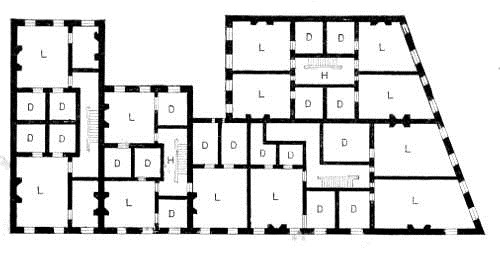
TENEMENT OF 1863, FOR TWELVE FAMILIES ON EACH FLAT. 4
D, dark. L, light. H, halls.
There was just one excuse for the early tenement-house builders, and their successors may plead it with nearly as good right for what it is worth. “Such,” says an official report, “is the lack of house-room in the city that any kind of tenement can be immediately crowded with lodgers, if there is space offered.” Thousands were living in cellars. There were three hundred underground lodging-houses in the city when the Health Department was organized. Some fifteen years before that the old Baptist Church in Mulberry Street, just off Chatham Street, had been sold, and the rear half of the frame structure had been converted into tenements that with their swarming population became the scandal even of that reckless age. The wretched pile harbored no less than forty families, and the annual rate of deaths to the population was officially stated to be 75 in 1,000. These tenements were an extreme type of very many, for the big barracks had by this time spread east and west and far up the island into the sparsely settled wards. Whether or not the title was clear to the land upon which they were built was of less account than that the rents were collected. If there were damages to pay, the tenant had to foot them. Cases were “very frequent when property was in litigation, and two or three different parties were collecting rents.” Of course under such circumstances “no repairs were ever made.”
The climax had been reached. The situation was summed up by the Society for the Improvement of the Condition of the Poor in these words: “Crazy old buildings, crowded rear tenements in filthy yards, dark, damp basements, leaking garrets, shops, outhouses, and stables5 converted into dwellings, though scarcely fit to shelter brutes, are habitations of thousands of our fellow-beings in this wealthy, Christian city.” “The city,” says its historian, Mrs. Martha Lamb, commenting on the era of aqueduct building between 1835 and 1845, “was a general asylum for vagrants.” Young vagabonds, the natural offspring of such “home” conditions, overran the streets. Juvenile crime increased fearfully year by year. The Children’s Aid Society and kindred philanthropic organizations were yet unborn, but in the city directory was to be found the address of the “American Society for the Promotion of Education in Africa.”

CHAPTER II.
THE AWAKENING
The dread of advancing cholera, with the guilty knowledge of the harvest field that awaited the plague in New York’s slums, pricked the conscience of the community into action soon after the close of the war. A citizens’ movement resulted in the organization of a Board of Health and the adoption of the “Tenement-House Act” of 1867, the first step toward remedial legislation. A thorough canvass of the tenements had been begun already in the previous year; but the cholera first, and next a scourge of small-pox, delayed the work, while emphasizing the need of it, so that it was 1869 before it got fairly under way and began to tell. The dark bedroom fell under the ban first. In that year the Board ordered the cutting of more than forty-six thousand windows in interior rooms, chiefly for ventilation—for little or no light was to be had from the dark hallways. Air-shafts were unknown. The saw had a job all that summer; by early fall nearly all the orders had been carried out. Not without opposition; obstacles were thrown in the way of the officials on the one side by the owners of the tenements, who saw in every order to repair or clean up only an item of added expense to diminish their income from the rent; on the other side by the tenants themselves, who had sunk, after a generation of unavailing protest, to the level of their surroundings, and were at last content to remain there. The tenements had bred their Nemesis, a proletariat ready and able to avenge the wrongs of their crowds. Already it taxed the city heavily for the support of its jails and charities. The basis of opposition, curiously enough, was the same at both extremes; owner and tenant alike considered official interference an infringement of personal rights, and a hardship. It took long years of weary labor to make good the claim of the sunlight to such corners of the dens as it could reach at all. Not until five years after did the department succeed at last in ousting the “cave-dwellers” and closing some five hundred and fifty cellars south of Houston Street, many of them below tide-water, that had been used as living apartments. In many instances the police had to drag the tenants out by force.
The work went on; but the need of it only grew with the effort. The Sanitarians were following up an evil that grew faster than they went; like a fire, it could only be headed off, not chased, with success. Official reports, read in the churches in 1879, characterized the younger criminals as victims of low social conditions of life and unhealthy, overcrowded lodgings, brought up in “an atmosphere of actual darkness, moral and physical.” This after the saw had been busy in the dark corners ten years! “If we could see the air breathed by these poor creatures in their tenements,” said a well-known physician, “it would show itself to be fouler than the mud of the gutters.” Little improvement was apparent despite all that had been done. “The new tenements, that have been recently built, have been usually as badly planned as the old, with dark and unhealthy rooms, often over wet cellars, where extreme overcrowding is permitted,” was the verdict of one authority. These are the houses that to-day perpetuate the worst traditions of the past, and they are counted by thousands. The Five Points had been cleansed, as far as the immediate neighborhood was concerned, but the Mulberry Street Bend was fast outdoing it in foulness not a stone’s throw away, and new centres of corruption were continually springing up and getting the upper hand whenever vigilance was relaxed for ever so short a time. It is one of the curses of the tenement-house system that the worst houses exercise a levelling influence upon all the rest, just as one bad boy in a schoolroom will spoil the whole class. It is one of the ways the evil that was “the result of forgetfulness of the poor,” as the Council of Hygiene mildly put it, has of avenging itself.








